Study on the Evolution and Predictive for Coordinated Development of Regional Water Resources, Economic Society, and Ecological Environment
Abstract
1. Introduction
2. Materials and Methods
2.1. Study Area
2.2. Methods
2.2.1. Coordination Degree Model
2.2.2. Holt Exponential Smoothing–Feedforward Neural Network Prediction Model
Holt Exponential Smoothing Method
Feedforward Neural Network
Holt Exponential Smoothing–Feedforward Neural Network Prediction Model
3. Results and Discussion
3.1. Index System of the Coordinated Development of Water Resources–Economic Society–Ecological Environment
3.2. Coordinated Development Evolution
3.2.1. Coordinated Development of Dual Systems
3.2.2. Coordinated Development of Water Resources–Economic Society–Ecological Environment System
Temporal Evolution
Spatial Evolution
3.3. Coordinated Development Prediction
3.3.1. Scenario Setting
- (1)
- Scenario 1 (S1): Status quo development. Maintaining the current development trend without taking any additional measures to promote the coordinated development of China’s water resources–economic society–ecological environment system, with the coordination degree under this scenario as the baseline value.
- (2)
- Scenario 2 (S2): Water resource priority. Full consideration will be given to the enhancement of China’s ability to defend against water and drought disasters as well as the advancement of soil erosion control, the strengthening of water resources system protection, and the improvement of the efficiency of water resources utilization.
- (3)
- Scenario 3 (S3): Economic society priority. Strengthening the benign development of the economic society system, increasing the rate of development of economic indicators on the existing basis and responding to the development of China’s urbanization process.
- (4)
- Scenario 4 (S4): Ecological environment priority. Enhancement of the degree of ecological civilization by increasing NDVI, etc., and enhancement of the urban ecological environment through the improvement of green coverage rate of built-up areas, etc.
- (5)
- Scenario 5 (S5): Balanced development. Improvement measures based on Scenarios 2~4 to promote synergistic management of water resources, economic and society, and ecological environment.
3.3.2. Typical Provinces
- (1)
- Development and use-driven type: Fujian. This province has both coastal and inland mountainous features, and it is confronted with resource and ecological pressures during its development process.
- (2)
- Water hazard risk-driven type: Jilin. This province is located in northeastern China and has a slightly weaker ability to resist flood disasters.
- (3)
- Economic foundation-driven type: Shandong. The province has a large economic scale and comprehensive coverage of industrial categories that can reflect resource constraints in the industrialization process.
- (4)
- Social development-driven type: Hebei. The contradiction between population and resources faced by this province is a typical problem in the process of social development.
- (5)
- Capital investment-driven type: Jiangxi. The province has a medium level of water financing and its development gradient is moderate.
- (6)
- Natural ecology-driven type: Henan. The province is located in central China and has a variety of landscapes, including mountains, hills, plains and basins. The province is representative of the ecological and resource pressures caused by its large population.
- (7)
- Sustainable development-driven type: Yunnan. This province is rich in ecological resources and has a sharp contradiction between population and land. Study of this province is of reference value for ecological advantage areas and provinces undergoing economic transformation and development.
- (8)
- Habitat environment-driven type: Hunan. The province is a transition zone connecting China’s eastern coastal areas with the central and western regions, and plays an important role in undertaking industrial transfer.
- (9)
- Water resource endowment-driven type: The role of water resources in coordinated regional development is multidimensional, and all provinces face conflicts between resource endowment and sustainable development. Consequently, there is no typical province for this driver type.
3.3.3. Validation of Holt Exponential Smoothing–Feedforward Neural Network Model
3.3.4. Prediction Results
4. Conclusions and Limitations
4.1. Conclusions
- (1)
- An evaluation system for the coordinated development of water resources–economic society–ecological environment was established, and the degree of its coordinated development was calculated. From the perspective of the coordinated evolution of the dual systems, the dominant development combination from 2011 to 2023 gradually transformed from water resources–economic society to water resources–ecological environment. From the perspective of the complex system, the coordination degree showed “stepped leap—resilient fluctuation”, and ”better in the southeast than in the northwest, with significant advantages in the coast”; the coordinated development of the two sides of the Hu Huanyong Line showed significant spatial variability.
- (2)
- The Holt exponential smoothing–feedforward neural network prediction model was constructed, and the coupling of the two models made up for their prediction defects for linear and nonlinear data. Based on this prediction model, the indicator data from 2024 to 2030 were predicted, and five different scenarios were set up: status quo development, water resource priority, economic society priority, ecological environment priority, and balanced development.
- (3)
- The coordination degrees of different driving types based on different scenarios were predicted. The results showed that the coordination degrees were most significantly improved under the scenarios of balanced development and economic society priority, verifying the efficient promotion of coordination by stable economic and social development. Under the ecological environment priority scenario, the coordination degrees were lowest in the development and utilization-driven type and water hazard risk-driven type. This indicates that achieving regional coordinated development requires balancing ecological protection and economic efficiency: coastal regions can prioritize the balanced development model, while inland regions with limited resources need to explore low-cost technological pathways. Future research should further quantify the long-term ecological costs under different scenarios to provide a more comprehensive basis for policy-making.
4.2. Limitations
- (1)
- The construction of the indicator system was constrained by data availability. This study utilized provincial-level administrative regions across China as the smallest research units, with indicator data sourced from national and regional statistical yearbooks and bulletins. However, two key shortcomings emerged: first, indicator data for some regions—such as Taiwan Province, Hong Kong Special Administrative Region, and Macao Special Administrative Region—were not fully included in the statistical data released by the relevant authorities, thereby compromising the territorial completeness of the study. Second, certain indicators that could effectively reveal system development patterns and coordinated growth dynamics were unavailable in the statistical data and had to be replaced with proxies, potentially weakening the study’s persuasiveness. Subsequent research could incorporate data mining techniques and remote sensing-based data interpretation methods to further enhance the territorial and indicator system completeness.
- (2)
- This study has certain limitations in scope. It focused on three systems—water resources, socio-economy, and ecological environment—but as understanding of inter-system relationships deepens, coordinated development across additional dimensions (e.g., energy systems, food systems) should be considered. By constructing more diversified coupled systems and incorporating issues such as governance and social participation into comprehensive considerations, the patterns and characteristics of coordinated development can be revealed more comprehensively.
- (3)
- The depth of research methodologies could be further expanded. This study introduced machine learning approaches into coordinated development evaluation and prediction, improving upon traditional evaluation methods and enhancing result reliability. However, rapid advancements in computer technology in recent years have yielded numerous deep learning algorithms with more complex mechanisms and rigorous logic. Future research could explore the integration of deep learning-based evaluation models to uncover deeper inter-system connections, thereby providing more robust technical support for coordinated development.
Author Contributions
Funding
Data Availability Statement
Conflicts of Interest
References
- Chen, Q.; Zhu, M.; Zhang, C.; Zhou, Q. The driving effect of spatial-temporal difference of water resources carrying capacity in the Yellow River Basin. J. Clean. Prod. 2023, 388, 135709. [Google Scholar] [CrossRef]
- Li, M.; Yang, X.; Wang, K.; Di, C.; Xiang, W.; Zhang, J. Exploring China’s water scarcity incorporating surface water quality and multiple existing solutions. Environ. Res. 2024, 1, 118191. [Google Scholar] [CrossRef] [PubMed]
- Han, J.; Wang, C.; Deng, S.; Lichtfouse, E. China’s sponge cities alleviate urban flooding and water shortage: A review. Environ. Chem. Lett. 2023, 21, 1297–1314. [Google Scholar] [CrossRef]
- Bosco, C.; Seglem, N.K.; Sivertsen, E.; Jovanovié, O.; Helness, H. Developing a framework to assess water smartness and sustainability of circular economy solutions in the water sector. J. Clean. Prod. 2025, 517, 145874. [Google Scholar] [CrossRef]
- Yang, G.; Dong, Z.; Feng, S.; Li, B.; Sun, Y.; Chen, M. Early warning of water resource carrying status in Nanjing City based on coordinated development index. J. Clean. Prod. 2021, 284, 124696. [Google Scholar] [CrossRef]
- Zhang, C.; Chen, X.; Li, Y.; Ding, W.; Fu, G. Water-energy-food nexus: Concepts, questions and methodologies. J. Clean. Prod. 2018, 195, 525–639. [Google Scholar] [CrossRef]
- Zou, S.; Liao, Z.; Liu, Y.; Fan, X. Research on the Impact of Heterogeneous Environmental Regulation on the Coordinated Development of China’s Water–Energy–Food System from a Spatial Perspective. Sustainability 2024, 16, 818. [Google Scholar] [CrossRef]
- Wang, Y.; Li, N.; Song, J.; Li, Q. Solving the sustainable development dilemma in the Yellow River Basin of China: Water-energy-food linkages. J. Clean. Prod. 2025, 490, 144797. [Google Scholar] [CrossRef]
- Tong, L.; Luo, M. Spatiotemporal Evolution Characteristics and Driving Factors of Water-Energy-Food-Carbon System Vulnerability: A Case Study of the Yellow River Basin, China. Sustainability 2024, 16, 1002. [Google Scholar] [CrossRef]
- Li, Z.; Li, X.; Wang, Y. Does Decentralized Food Crop Cultivation Threaten Water-Land-Food Nexus? A Spatial Econometric Analysis. Water 2023, 15, 1096. [Google Scholar] [CrossRef]
- Enteshari, S.; Safavi, H.R.; van der Zaag, P. Simulating the interactions between the water and the socio-economic system in a stressed endorheic basin. Hydrol. Sci. J. 2020, 65, 2159–2174. [Google Scholar] [CrossRef]
- Haak, L.; Pagilla, K. The Water-Economy Nexus: A Composite Index Approach to Evaluate Urban Water Vulnerability. Water Resour. Manag. 2020, 34, 409–423. [Google Scholar] [CrossRef]
- Ren, B.; Sun, B.; Shi, X.; Zhao, S.; Wang, X. Analysis of the Cooperative Carrying Capacity of Ulan Suhai Lake Based on the Coupled Water Resources-Water Environment-Water Ecology System. Water 2022, 14, 3102. [Google Scholar] [CrossRef]
- Zhang, Z.; Qi, J.; Wang, Q.; Wang, S.; Hu, F. Analysis and forecast of the coupled development level of socioeconomy ecological environment and tourism in China’s Yellow River Basin. Sci. Rep. 2025, 15, 5446. [Google Scholar] [CrossRef]
- Khare, R.; Villuri, V.G.K.; Chaurasia, D. Urban sustainability assessment: The evaluation of coordinated relationship between BRTS and land use in transit-oriented development mode using DEA model. Ain Shams Eng. J. 2021, 12, 107–117. [Google Scholar] [CrossRef]
- Luo, Z.; Zuo, Q. Evaluating the coordinated development of social economy, water, and ecology in a heavily disturbed basin based on the distributed hydrology model and the harmony theory. J. Hydrol. 2019, 574, 226–241. [Google Scholar] [CrossRef]
- Lu, Z.; Feng, Q.; Xiao, S.; Xie, J.; Zou, S.; Yang, Q.; Si, J. The impacts of the ecological water diversion project on the ecology-hydrology-economy nexus in the lower reaches in an inland river basin. Resour. Conserv. Recycl. 2021, 164, 105154. [Google Scholar] [CrossRef]
- Wang, X.; Liu, L.; Zhang, S.; Gao, C. Dynamic simulation and comprehensive evaluation of the water resources carrying capacity in Guangzhou city, China. Ecol. Indic. 2022, 135, 108528. [Google Scholar] [CrossRef]
- Chen, W.; Chen, Y.; Feng, Y. Assessment and Prediction of Water Resources Vulnerability Based on a NRS-RF Model: A Case Study of the Song-Liao River Basin, China. Entropy 2021, 23, 882. [Google Scholar] [CrossRef]
- Zhou, R.; Jin, J.; Wu, C.; Zhou, L.; Zhang, L.; Cui, Y.; Zhang, Y.; Zhou, Y. Connection number based model for coordination development evaluation of regional water resources, social economy and ecological environment complex system. J. Environ. Manag. 2023, 339, 117913. [Google Scholar] [CrossRef]
- Wang, X.; Dong, Z.; Xu, W.; Luo, Y.; Zhou, T.; Wang, W. Study on Spatial and Temporal Distribution Characteristics of Coordinated Development Degree among Reginal Water Resources, Social Economy, and Ecological Environment Systems. Int. J. Environ. Res. Public Health 2019, 16, 4213. [Google Scholar] [CrossRef]
- Lü, S.; Lü, C.; Liu, P.; Zhao, H.; Wang, F. Regional water cycle health evaluation and obstacle factor analysis: A case study of the Yellow River basin in Henan Province, China. Ecol. Indic. 2024, 166, 112500. [Google Scholar] [CrossRef]
- Caiado, J. Performance of combined double seasonal univariate time series models for forecasting water demand. J. Hydrol. Eng. 2010, 15, 215–222. [Google Scholar] [CrossRef]
- Wang, X.; Tian, W.; Liao, Z. Framework for Hyperparameter Impact Analysis and Selection for Water Resources Feedforward Neural Network. Water Resour. Manag. 2022, 36, 4201–4217. [Google Scholar] [CrossRef]
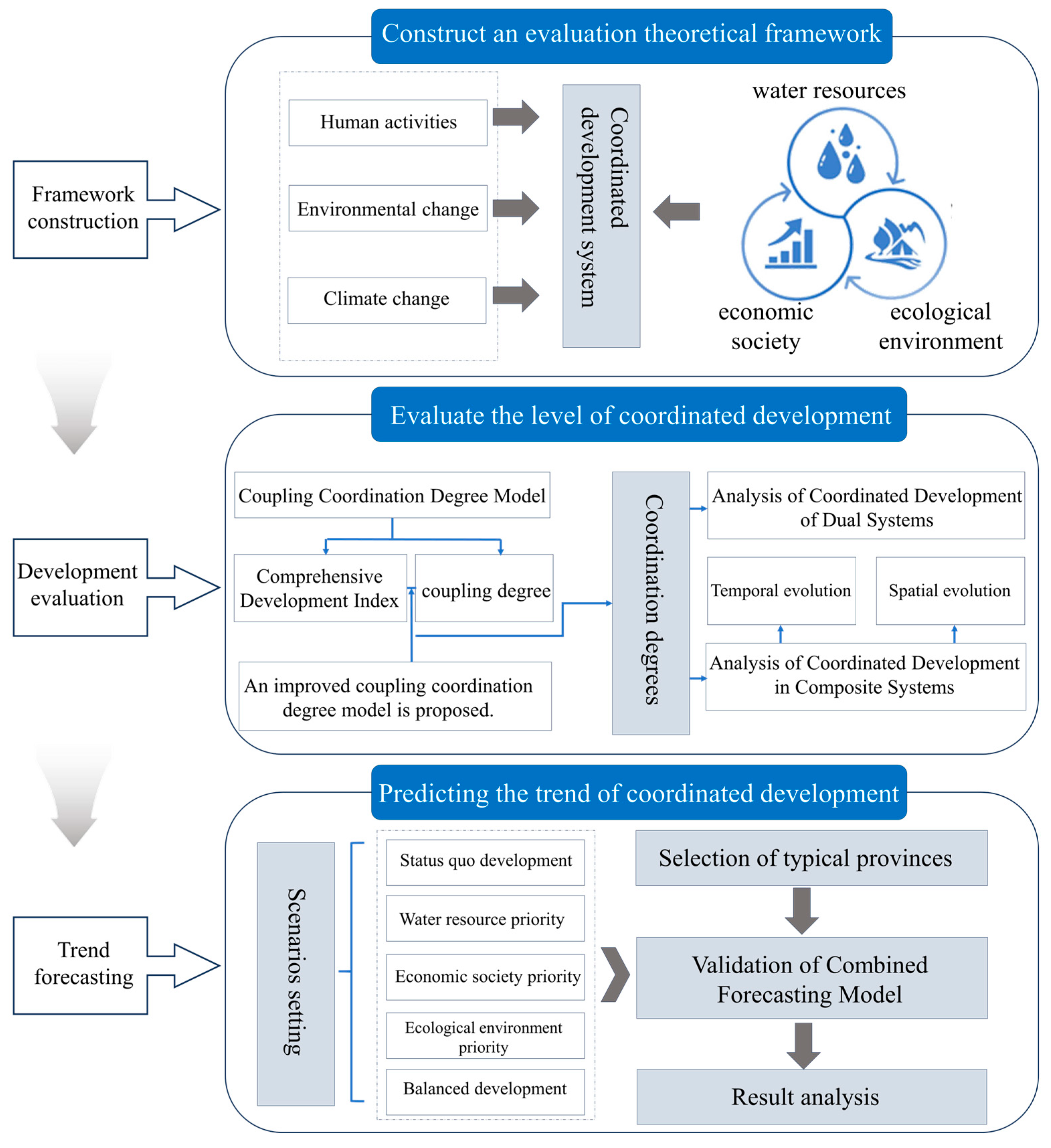
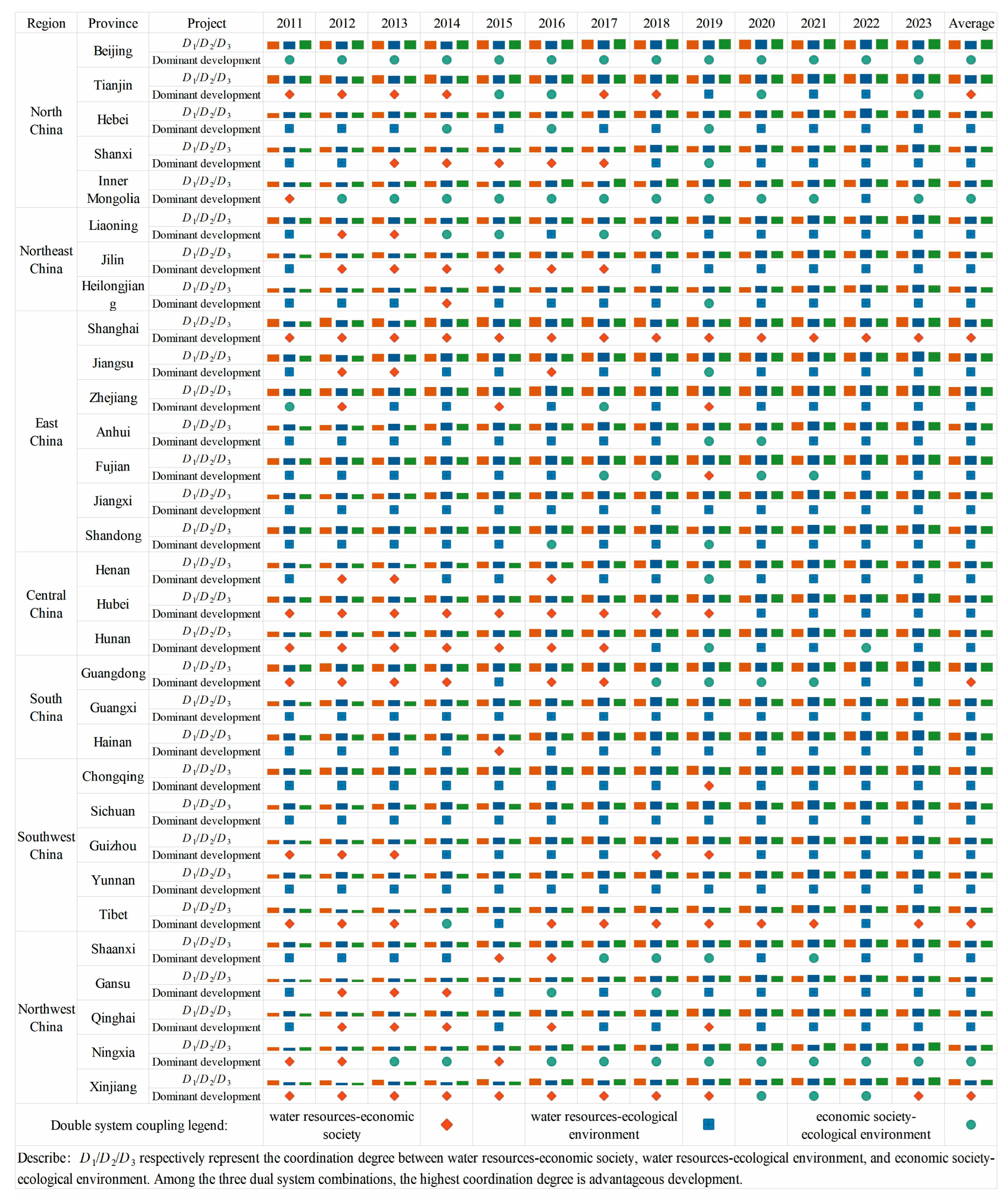
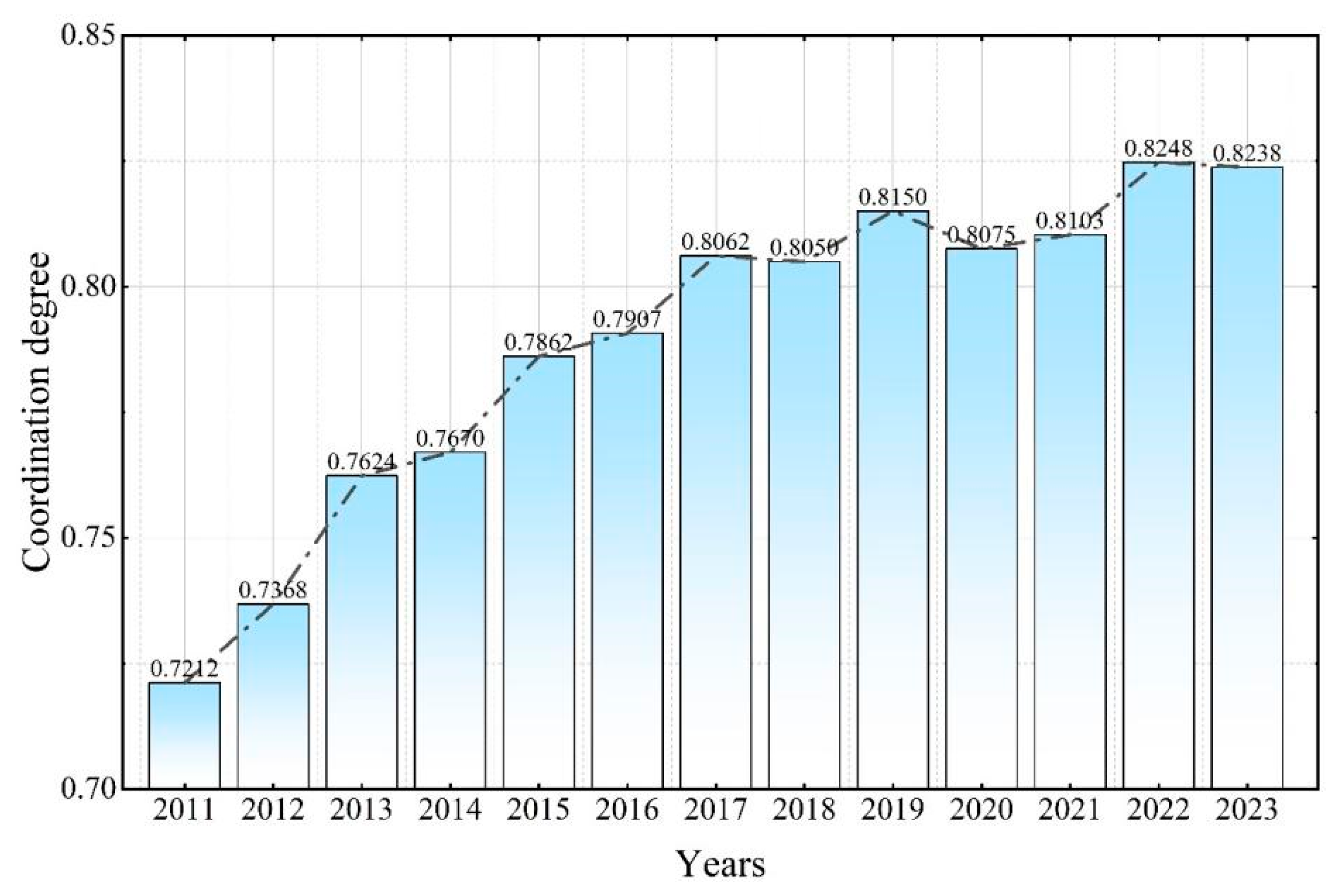

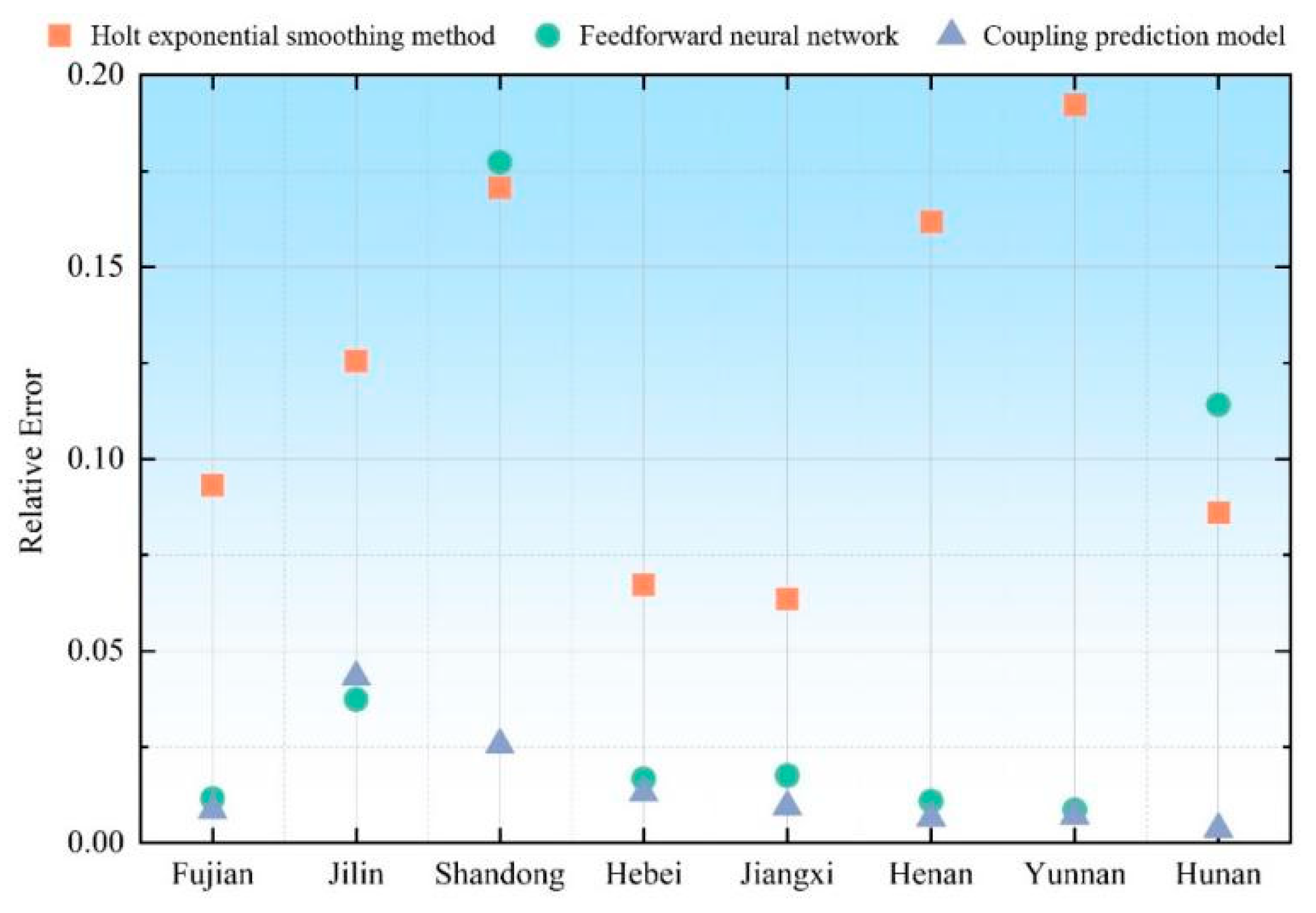
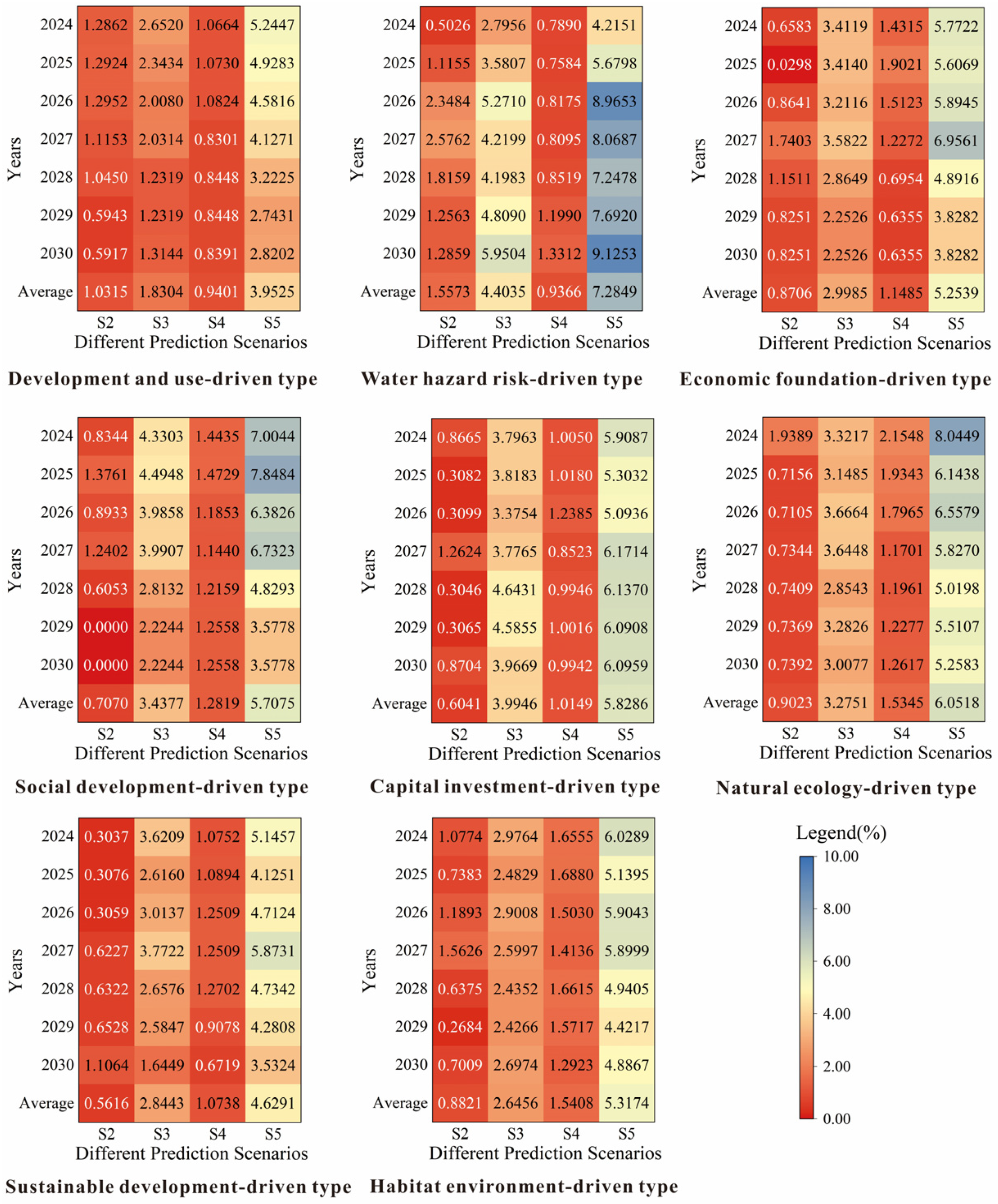
| Criterion Layer | Element Layer | Indicator Layer | Unit | Characteristic |
|---|---|---|---|---|
| Water resources subsystem | Water resource endowment | Per capita water resources | m3 | + |
| Water yield modulus | 10,000 m3/km2 | + | ||
| Development and use | Percentage of groundwater supply | % | − | |
| Per capita domestic water consumption | m3 | + | ||
| Water consumption per CNY 10,000 of GDP | m3 | − | ||
| Water consumption for CNY 10,000 of industrial added value industry | m3 | − | ||
| Average acreage of water use for agricultural irrigation | m3 | − | ||
| Water hazard risk | Proportion of area affected by drought and water damage to crops | % | − | |
| Fluctuation range of precipitation | % | − | ||
| Percentage of soil and water loss area | % | − | ||
| Economic society subsystem | Economic foundation | Per capita GDP | CNY 10,000 | + |
| Per capita gross product of industry | CNY 10,000 | + | ||
| Per capita disposable income of urban residents | CNY 10,000 | + | ||
| Social development | Population density | ‰ | + | |
| Urbanization rate | % | + | ||
| Natural population growth rate | ‰ | + | ||
| Percentage of area under cash crops | % | + | ||
| Grain production per unit area | t/hm2 | + | ||
| Percentage of tertiary GDP | % | + | ||
| Percentage of employees in the tertiary sector | % | + | ||
| Capital investment | Percentage of expenditure on science and technology | % | + | |
| Percentage of expenditure on agriculture, forestry and water affairs | % | + | ||
| Percentage of investment in the water sector | % | + | ||
| Ecological environment subsystem | Natural ecology | Forest cover | % | + |
| Percentage of wetland area | % | + | ||
| Normalized difference vegetation index | --- | + | ||
| Sustainable development | Percentage of ecological water use | % | + | |
| Sewage treatment rate | % | + | ||
| Drainage network density | km/km2 | + | ||
| Percentage of recycled water supply | % | + | ||
| Percentage of cleaner electricity generation | % | + | ||
| Chemical oxygen demand emissions per 10,000 yuan of GDP | kg | - | ||
| Habitat environment | Green coverage rate of built-up area | % | + | |
| Harmless treatment rate of domestic waste | % | + | ||
| Per capita parkland area | m2 | + |
Disclaimer/Publisher’s Note: The statements, opinions and data contained in all publications are solely those of the individual author(s) and contributor(s) and not of MDPI and/or the editor(s). MDPI and/or the editor(s) disclaim responsibility for any injury to people or property resulting from any ideas, methods, instructions or products referred to in the content. |
© 2025 by the authors. Licensee MDPI, Basel, Switzerland. This article is an open access article distributed under the terms and conditions of the Creative Commons Attribution (CC BY) license (https://creativecommons.org/licenses/by/4.0/).
Share and Cite
Lü, S.; Lü, C.; Wang, T.; Shao, W.; Wang, F. Study on the Evolution and Predictive for Coordinated Development of Regional Water Resources, Economic Society, and Ecological Environment. Water 2025, 17, 2093. https://doi.org/10.3390/w17142093
Lü S, Lü C, Wang T, Shao W, Wang F. Study on the Evolution and Predictive for Coordinated Development of Regional Water Resources, Economic Society, and Ecological Environment. Water. 2025; 17(14):2093. https://doi.org/10.3390/w17142093
Chicago/Turabian StyleLü, Subing, Cheng Lü, Tingyu Wang, Weiwei Shao, and Fuqiang Wang. 2025. "Study on the Evolution and Predictive for Coordinated Development of Regional Water Resources, Economic Society, and Ecological Environment" Water 17, no. 14: 2093. https://doi.org/10.3390/w17142093
APA StyleLü, S., Lü, C., Wang, T., Shao, W., & Wang, F. (2025). Study on the Evolution and Predictive for Coordinated Development of Regional Water Resources, Economic Society, and Ecological Environment. Water, 17(14), 2093. https://doi.org/10.3390/w17142093








